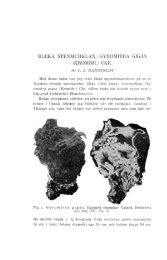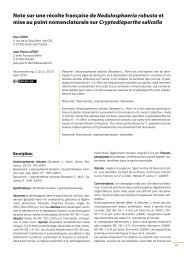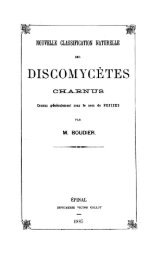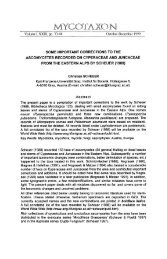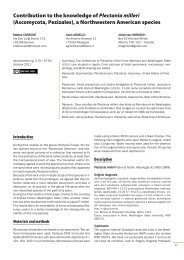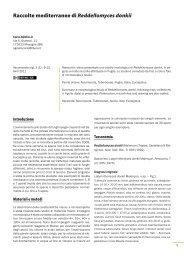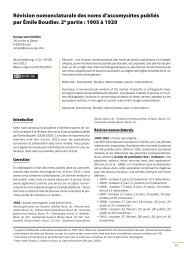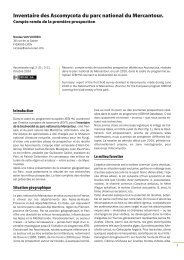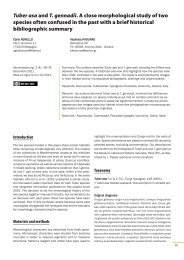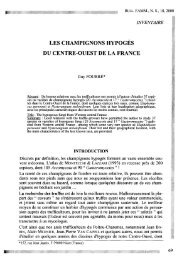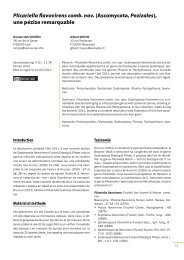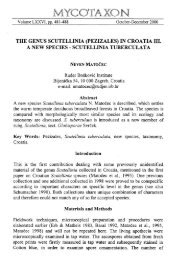AscomyceteOrg 05-01_AscomyceteOrg
AscomyceteOrg 05-01_AscomyceteOrg
AscomyceteOrg 05-01_AscomyceteOrg
Create successful ePaper yourself
Turn your PDF publications into a flip-book with our unique Google optimized e-Paper software.
2<br />
somataceae, the genus is mainly characterized by its spherical<br />
smooth spores. It was thought to be independent by many authors,<br />
(SEAVER, 1928; NANNFELDT, 1949; LE GAL, 1953; SANWAL, 1953; BERTHET,<br />
1964; KREISEL, 1962; ECKBLAD, 1968; RIFAI, 1968; KORF, 1972, 1973).<br />
However, other workers (KORF, 1982; PADEN, 1983) considered it to<br />
be a synonym of Plectania sect. Sphaerosporae mainly due to the<br />
discovery of a Conoplea conidial state in Pseudoplectania melaena<br />
and because of Plectania’s rounded spores in their early development.<br />
From that time on, Paden’s wide concept of Plectania was largely<br />
agreed (KORF & ZHUANG, 1991; MEDEL & CHACÓN, 2000; CALONGE &<br />
MATA, 2002; CALONGE et al., 2003; BENKERT, 20<strong>05</strong>; PERÉZ-DE-GREGORIO et<br />
al., 2009), as can be seen in the description of Plectania carranzae<br />
Calonge & Mata and the new combination Plectania ericae (Donadini)<br />
Roqué. Still other authors (DONADINI, 1987; BELLEMÈRE et al., 1990)<br />
argued that Pseudoplectania was different on the basis of its<br />
ultrastructure and so they decided to preserve it as a separate<br />
genus.<br />
Finally, the genus Donadinia was proposed by BELLEMÈRE et al.<br />
(1990), who typified it with Donadinia helvelloides (Donadini, Berthet<br />
& Astier) Bellem. & Mel.-Howell (≡ Urnula helvelloides Donadini,<br />
Berthet & Astier), a species discovered in France and published by<br />
DONADINI et al. (1973). This genus was primarily characterized by the<br />
ultrastructural features of its ascus apex and ornamented spores.<br />
The type specimen was recently studied by CARBONE et al. (2<strong>01</strong>2a)<br />
who reduced Donadinia, from a morphological point of view, to a<br />
section within Plectania. According to these authors, other species<br />
putatively related to it could be Urnula lusitanica Torrend & Boud.<br />
and Plectania nannfeldtii Korf, while Plectania coelopus (Mont.) Sacc.<br />
should be considered a nomen dubium. Recently CARBONE et al.<br />
(2<strong>01</strong>2b) described Plectania seaveri M. Carbone, Agnello & La Greca<br />
from Bermuda, a species definitely belonging to this lineage in all<br />
respects.<br />
The present work aims to further delimit the molecular and morphological<br />
concept of the mentioned genera Plectania, Urnula, Pseudoplectania,<br />
Donadinia, Sarcosoma and Galiella, as well as to test the<br />
morphology-based taxonomy of several species in these genera in<br />
light of newly obtained molecular data. Unfortunately, Korfiella has<br />
not been included due to the temporary absence of available samples.<br />
Material and methods<br />
Morphological study. — The microscopic studies were based on<br />
both fresh and dried specimens. Two optical microscopes were<br />
used: Olympus CX41 trinocular and Optika B353 trinocular with<br />
plan-achromatic objectives 4×, 10×, 40×, 60×, 100× in oil immersion.<br />
The following main reagents were used: Melzer’s reagent, cotton<br />
blue, Congo red, KOH. Water mounts were used for the<br />
observation of the pigmentation and measurements. At least 30<br />
spores were measured from each apothecium. Species concepts<br />
have been based on the original descriptions and, in some cases,<br />
on the type revisions and selections.<br />
DNA extraction, amplification and sequencing. — DNA was extracted<br />
and amplified from dried specimens following the methods published<br />
before (ALVARADO et al., 2<strong>01</strong>0, ALVARADO et al., 2<strong>01</strong>2). The<br />
primers LR1 (TUINEN et al., 1998) and LR7 (VILGALYS & HESTER, 1990) were<br />
used to amplify and sequence the 28S nuclear large ribosomal region<br />
(nrLSU), while ITS1F and ITS4 (WHITE et al., 1990, GARDES & BRUNS,<br />
1993) were used to amplify the internal transcribed spacer region.<br />
Sequences were visually inspected searching for reading errors in<br />
MEGA 5.0 (TAMURA et al., 2<strong>01</strong>1). Validated sequences were stored in<br />
GenBank under the accession numbers listed in table I.<br />
Phylogenetic analyses. — The sequences obtained were aligned<br />
with the closest relatives and their matches obtained with BLAST<br />
searches. Sequences were first aligned in MEGA 5.0 software using<br />
its ClustalW application and then corrected manually. Final alignments<br />
were uploaded in TreeBase (ID13387). Neighbor-joining phylogenetic<br />
inference was performed in MEGA 5.0 (pairwise deletion<br />
of gaps, 2000 bootstrap replicates). The aligned loci were loaded in<br />
PAUP* 4.0b 10 (SWOFFORD, 20<strong>01</strong>) and a maximum parsimony phylogenetic<br />
tree reconstruction was performed (2000 bootstrap replicates,<br />
TBR swapping algorithm, 50 sequence additions per replicate,<br />
MulTrees not in effect). Aligned loci were also subjected to MrModeltest<br />
2.3 (NYLANDER, 2004) in PAUP* 4.0b10. The best models were<br />
implemented in MrBayes 3.1 (RONQUIST & HUELSENBECK, 2003), where<br />
a Bayesian analysis was performed (ITS1-5.8S-ITS2 data partitioned,<br />
2 simultaneous runs, 6 chains, temperature set to 0.2, sampling<br />
every 100th generation) until convergence parameters were met<br />
after about 2,5M generations. Significance thresholds were above<br />
70% for bootstrap (BP) and 99% for posterior probability (PP).<br />
Studied and sequenced collections<br />
Donadinia helvelloides: FRANCE, Var, Saint Baume, on Taxus baccata,<br />
spring 1972, leg. Donadini & Astier, det. P. Berthet (LY P.B. 940, isotype).<br />
Donadinia lusitanica: ITALY, Apulia, Brindisi, Bosco Zundrano,<br />
on mossy sticks of Pinus halepensis, 22.02.2<strong>01</strong>0, leg. et det. A. Baglivo<br />
& D. De Giorgi (TUR-A 195791); GREECE, Kefalovryso, Larissa, on Pinus<br />
halepensis, <strong>05</strong>.<strong>01</strong>.2000, leg. A. Papatsanis, det. C. Agnello & M. Carbone<br />
(TUR-A 195792). Donadinia nigrella: USA, Idaho, Kootenay<br />
County, 1100 m a.s.l., 07.<strong>05</strong>.1985, leg. et det. K. Scates & H.E. Barnhardt<br />
(TUR-A 195793). Neournula pouchetii: ITALY, Apulia, Mesagne<br />
(BR), Contrada Manfredonia, in a private garden under Cedrus atlantica,<br />
15.03.2009, leg. et det. C. Agnello (TUR-A 195798). Plectania<br />
melastoma: ITALY, Tuscany, Marina di Vecchiano, on Erica scoparia,<br />
26.04.2<strong>01</strong>2, leg. et det. M. Carbone & G. Cacialli (TUR-A 195783); ITALY,<br />
Apulia, Brindisi, Bosco Preti, on Erica arborea, 28.04.2<strong>01</strong>2, leg. et det.<br />
C. Agnello (TUR-A 195784). Plectania megalocrater: GREECE, Ziakas<br />
Grevena, along with Quercus cerris and Acer pseudoplatanus,<br />
15.<strong>05</strong>.2<strong>01</strong>1, leg. G. Palatsios, det. M. Carbone & C. Agnello (TUR-A<br />
195803). Plectania cf. melastoma: USA, Montana, Cedar Creek Trail,<br />
moist areas along the trail, under conifers as well as on decaying<br />
wood, 31.07.2<strong>01</strong>1, leg. J. Harnisch, det. M. Carbone & C. Agnello (TUR-<br />
A 195785). Plectania milleri: USA, Montana, Trego, under Larix,<br />
11.06.2<strong>01</strong>1, leg. J. Harnisch, det. M. Carbone, C. Agnello & J. Harnisch<br />
(TUR-A 190823). Plectania rhytidia: ITALY, Apulia, Brindisi, Bosco Preti,<br />
on Erica arborea, 24.04.2<strong>01</strong>2, leg. et det. C. Agnello (TUR-A 195786);<br />
ITALY, Apulia, Brindisi, Bosco Colemi, on Quercus ilex and Q. suber,<br />
18.04.2<strong>01</strong>2, leg. et det. C. Agnello (TUR-A 195787); ITALY, Apulia, Taranto,<br />
Torre Colimena, on Eucalyptus camaldulensis, 31.<strong>01</strong>.2<strong>01</strong>2, leg.<br />
et det. C. Agnello (TUR-A 195788); NEW ZEALAND, Taupo, vic. Kiko Rd.,<br />
Tiraki Rd., on soil and litter in Nothofagus forest, 21.11.20<strong>01</strong>, leg.<br />
K. Petersen & P.R. Johnston, det. P.R. Johnston (PDD 75313); NEW ZEA-<br />
LAND, Northland, Native Forests Restoration Trust, Cynthia Hewett<br />
Reserve, on litter, 28.11.2006, leg. P.R. Johnston & B. Paulus, det.<br />
P.R. Johnston (PDD 90028). Plectania zugazae: SPAIN, Valladolid, Valdestillas,<br />
among mosses under Pinus sp., 08.04.20<strong>01</strong>, leg. A. Garcia<br />
Blanco & J. Mori, det. F.D. Calonge (AVM 1467, private duplicate of<br />
the holotype MA-fungi 53068); Spain, Valladolid, Valdestillas, among<br />
Legend of the plates<br />
Plate 1 – 1. Galiella rufa (A.D. Parker); 2. Urnula craterium (C. Zoldan);<br />
3. U. hiemalis (S. Kytöharju); 4. U. padeniana (A.D. Parker); 5. U.<br />
campylospora (G. Gates); 6. U. mediterranea (C. Agnello); 7. Plectania<br />
melastoma (C. Agnello).<br />
Plate 2 – 8. Plectania zugazae (A. Garcia Blanco); 9. P. megalocrater<br />
(G. Paliatsios); 10. P. milleri (J. Harnisch); 11. P. rhytidia (C. Agnello);<br />
12. Sarcosoma globosum (J. Vauras); 13. Pseudoplectania nigrella (M.<br />
Carbone); 14. P. ericae (C. Roqué); 15. P. melaena (M. Carbone).<br />
Plate 3 – 16. Donadinia nigrella (A.D. Parker); 17. D. helvelloides holotypus<br />
(M. Carbone); 18. D. lusitanica (A. Baglivo); 19. D. seaveri (F.J.<br />
Seaver); 20. Trichaleurina javanica (M. Carbone); 21. T. celebica (K. Saitoh);<br />
22. Pseudosarcosoma latahensis (A.D. Parker); 23. Neournula<br />
pouchetii (C. Agnello).



